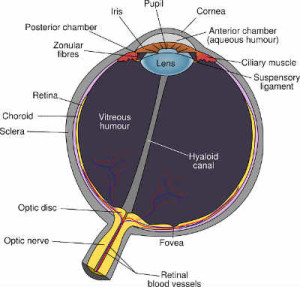How do your eyes work? Do you know? If you are going to understand optimal optical health, it is important that you know the parts of your eye and how they all work together to help you see.
The Front of the Eye Ball
At the front of your eye, there are 4 main parts. Let’s go through each of them as if we are light passing through the eye.
 First, we encounter the cornea. This is the transparent outer part of the eye. As the light passses through the cornea, the covering bends the light, which then passes through a the round, black hole in the middle of your eye. This is called the pupil. Surrounding the pupil is the iris, or the colored part of your eye. Think of this as a sliding door. It opens and closes around the pupil to make it bigger or smaller so that more light can get through at different times. For example, your iris will appear smaller and your pupil will be bigger in a dark room, because it is trying to let in as much light as possible.
First, we encounter the cornea. This is the transparent outer part of the eye. As the light passses through the cornea, the covering bends the light, which then passes through a the round, black hole in the middle of your eye. This is called the pupil. Surrounding the pupil is the iris, or the colored part of your eye. Think of this as a sliding door. It opens and closes around the pupil to make it bigger or smaller so that more light can get through at different times. For example, your iris will appear smaller and your pupil will be bigger in a dark room, because it is trying to let in as much light as possible.
Behind the pupil is the lens of your eye. This is just like any lens, and light will act just like it does if you pass it through a crystal or magnifying glass: it will bend. The lens redirects the light rays to the back of the eye, where it is then processed even more and sent to the brain.
Moving on Back
The back of the eye is where a lot of the action happens. The first part we encounter is the retina. The lens passes the light on to the retina, which is a thin, thin tissue layer that is located at the very back of the eye. This part of the eye contains so many sensitive nerves. These are called rods and cones.
The Difference Between Rods and Cones
Most of the cones are located in the center of the retina in what is called the macula. These give you great central vision. Thanks to cones you can see colors and details clearly. In contrast, rods are outside the macula and help you with your peripheral vision, especially with motion and in bad lighting or darkness.
These cells change the light from rays into electrical signals that are then sent to the brain via the optic nerve. It is not until these signals reach the brain that you actually see an image. And there you have it!
